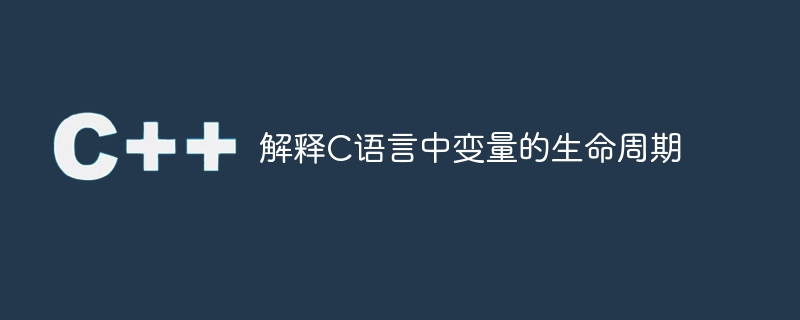Home >Backend Development >C++ >Explain the life cycle of variables in C language
Explain the life cycle of variables in C language
- WBOYWBOYWBOYWBOYWBOYWBOYWBOYWBOYWBOYWBOYWBOYWBOYWBforward
- 2023-09-02 19:37:071758browse

The storage class specifies the scope, life cycle and binding of the variable.
To fully define a variable, it is necessary to mention not only its "type" but also its storage class.
A variable name identifies a physical location in computer memory where a set of bits is allocated to store the variable's value.
The storage class tells us the following factors -
- Where are the variables stored (in memory or CPU registers)?
- If there is no initialization, what is the initial value of the variable?
- What is the scope of a variable (the scope of the variable that can be accessed)?
- What is the life cycle of a variable?
Lifetime
The lifetime of a variable defines the duration for which the computer allocates memory for it (the duration between memory allocation and deallocation).
In C language, variables can have automatic, static or dynamic life cycle.
- Automatic - Create variables with automatic lifecycle. Each time, their manifesto was met and destroyed. Additionally, their blocks will also exit.
- static - A variable is created the first time the declaration is executed. It is destroyed when execution stops/terminates.
- Dynamic - Variable memory is allocated and released through memory management functions.
Storage Class
There are four storage classes in C language-
| Storage Class | Storage Area | Default initial value | Life cycle | Scope | Keyword |
|---|---|---|---|---|---|
| Auto | Memory | Until control remains in the block | Until control remains in the block | Local | Automatic |
| Registers | CPU Registers | Garbage Value | Until control remains in the block | Local | Register |
| static | memory | zero | value between function calls | local | static |
| External | Memory | Garbage value | Entire program execution | Global | External | tr>
Example
The following is a C program for the automatic storage class-
Live Demo
#include<stdio.h>
main ( ){
auto int i=1;{
auto int i=2;{
auto int i=3;
printf ("%d",i)
}
printf("%d", i);
}
printf("%d", i);
}Output
When executing the above program, the following output will be produced-
3 2 1
Example
The following is a C program for the external storage class-
Live demonstration
#include<stdio.h>
extern int i =1; /* this ‘i’ is available throughout program */
main ( ){
int i = 3; /* this ‘i' available only in main */
printf ("%d", i);
fun ( );
}
fun ( ) {
printf ("%d", i);
}Output
When executing the above program, the following output is produced -
3 1
The above is the detailed content of Explain the life cycle of variables in C language. For more information, please follow other related articles on the PHP Chinese website!

